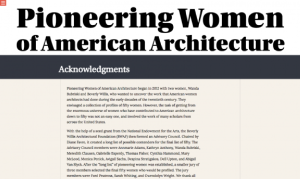Research and Education
Back to Top
|
 |
|
The National Archives: Education Sessions and Resources
|
Social studies |
|
History educators will appreciate this trove of resources from the UK National Archives. This collection contains over 150 classroom resources that cover a myriad of aspects of (primarily) British history from 1066 CE to the present day. Resources include lesson plans, interactive games, teachers' notes, and more. These resources are searchable by time period, ages of students, and by resource type, and many of the lessons are designed in a way that employs inquiry-based learning and encourages students to think critically. Although these resources have largely been created for a British audience, non-UK educators will also find much here that they can make use of in their own classrooms. For example, there are resources on the American civil rights movement, World War Two, and the French Revolution, as well as lessons exploring ways to learn from historical photographs. Educators in the UK school system may be interested in this collection's video conference, virtual classroom, and live workshop offerings, which can also be browsed on this website. [JDC] |
|





|
|
 |
|
Science in the Classroom: Concussions: A Century of Controversy and Research
|
Health |
|
In the past several years, researchers and the general public alike have become increasingly concerned about health risks associated with American football, as recent research has linked football-related concussions to Chronic Traumatic Encephalopathy (CTE). Although this research about CTE is new, concern about the health risks associated with this popular sport date back over 100 years. In 1905, the Salt Lake Tribune reported that nineteen high school and college level football players had died from injuries related to the sport over the past year, sparking an early twentieth century movement to reform the dangerous sport. From the AAAS's Science in the Classroom series comes this collection of educational resources related to the history of health concerns regarding American football. These resources include 1905 newspaper articles from the Library of Congress's archive, contemporary news articles, and an annotated research guide. These resources are accompanied by a series of suggested classroom activities, discussion questions, and relevant learning standards, which visitors will find by downloading the Educator's Guide. In addition to addressing CTE in football players, some of these resources address how CTE impacts military veterans. [MMB] |
|





|
|
 |
|
 |
|
Disability Studies Quarterly
|
Social studies |
|
Disability Studies Quarterly, published by The Ohio State University Libraries, is the academic journal for the Society of Disability Studies. This multidisciplinary international journal holds appeal for scholars across a broad range of fields, such as the social sciences, the humanities, and creative writers. Disability Studies Quarterly focuses on fostering theoretical knowledge, as well as exploring the lived experiences of disabled people, and it aims to stimulate intellectual debate and conversation around and across its many disciplines. Topics from its most recent issue include humor and storytelling, gender and sexuality, and reframing conventions and rhetoric surrounding the lives of people with disabilities. Each issue also includes reviews of books and media relevant to disability studies. In addition to this journal's academic audience, disability rights advocates and others interested in issues concerning disabled people would find value in this resource. [JDC] |
|





|
|
 |
|
 |
|
French Revolution Digital Archive
|
Social studies |
|
A collaboration between Stanford University Libraries and the Bibliotheque Nationale de France, this extensive resource contains two collections of key historical sources on the French Revolution. The first collection, Parliamentary archives, covers the years 1787-1794 and consists of 82 volumes of curated primary sources in chronological order, including parliamentary records, letters, and speeches. These are available as both scanned and text documents, and the text has been marked up to be easily searchable. The documents in this collection are only available in the original French, but the website is available in both French and English. The second collection, Images of the French Revolution, is a trove of approximately 12,000 high-resolution visual sources. This collection consists mainly of prints but also includes illustrations and images of medals, coins, and other objects. Each item is accompanied by extensive metadata to make the collection searchable, and it can also be browsed by category and theme. While the first collection is intended for scholarly audiences, the second will appeal to the general public, as well as to academics. Together, these collections make the French Revolution Digital Archive an exceptionally valuable resource. [JDC] |
|





|
|
 |
|
 |
|
Mapping Islamophobia
|
Social studies |
|
Mapping Islamophobia is a project headed by Grinnell College history and religious studies professor Caleb Elfenbein, with contributions from a number of Grinnell College students and technical support from Mike Conner. The project utilizes a series of powerful interactive maps that document incidents of violence, discrimination, and bias targeting Muslim individuals and communities in the United States. One such map, along with an accompanying interactive timeline, allows visitors to view the prevalence of Islamophobia between the years 2011 and 2018. In addition, these maps allow visitors to investigate Islamophobic incidents by incident type (including legislation, public campaigns, and crimes against people) and the gender of the targeted individual. The team behind Mapping Islamophobia collected information about these incidents from a variety of "media outlets with clear editorial oversight." By selecting individual pins on these maps, visitors can learn more about specific incidents and news sources. The Mapping Islamophobia project also contains Countering Islamophobia, an interactive map that documents "how American Muslim communities have responded to the increasing presence of anti-Muslim hostility in American public life over time." This map highlights community outreach activities, interfaith initiatives, and more. [MMB] |
|





|
|




















